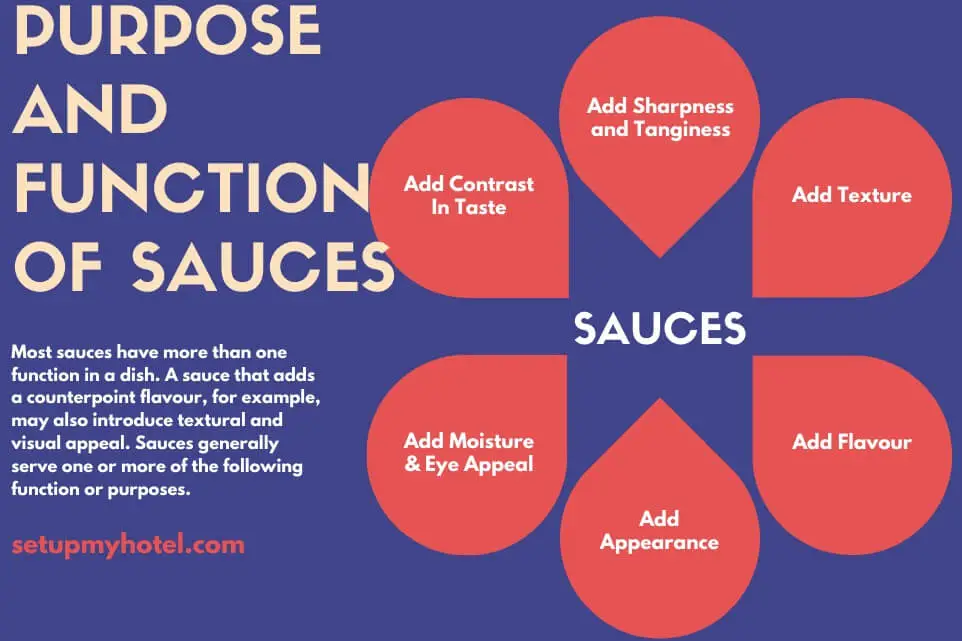The Purpose and Function of Sauces in Culinary Work
Sauces play an essential role in culinary work. They serve as a flavor enhancers, help bring together diverse ingredients, and can transform a dish into a masterpiece. Sauces come in different varieties, and each has its unique flavor, texture, and aroma. Whether it’s a tomato-based sauce, creamy sauce, or a tangy vinaigrette, sauces can take a dish from ordinary to extraordinary.
In addition to providing flavour, sauces also serve a functional purpose. They can be used to tenderize meat, add moisture to a dish, and even thicken a sauce or soup. Sauces can also be used to give a dish a specific texture, such as a velvety smoothness or a chunky consistency.
Sauces are a versatile ingredient and can be used in various dishes, from appetizers to main courses to desserts. Chefs often experiment with different sauces to create unique flavor combinations and elevate their cooking to the next level. Overall, sauces are a crucial component of culinary work and can make all the difference in a dish’s taste and presentation.
Most sauces have more than one function in a dish. A sauce that adds a counterpoint flavor, for example, may also introduce textural and visual appeal. Sauces generally serve one or more of the following functions or purposes.
- Flavor Enhancement:
- Sauces add depth, richness, and complexity to the flavor profile of a dish. They can transform a simple preparation into a more sophisticated and enjoyable culinary experience.
- Add Sharpness and Tanginess:
- Some sauces are used to add sharpness or tanginess to a portion of bland food. A remoulade sauce served with shrimp is an example of a piquant sauce.
- Moisture and Juiciness:
- Sauces can add moisture to dishes, preventing them from being dry or overcooked. This is particularly important for proteins like meats and poultry, ensuring they remain juicy and tender.
- A sauce can add moisture to naturally lean foods such as poultry, and fish. A sauce can also compensate for the drying effect of certain cooking techniques, especially broiling, grilling, sautéing, and roasting.
- Grilled foods may be served with a warm butter emulsion sauce like béarnaise or with compound butter. Beurre blanc is often served with shallow-poached lean white fish to add a bit of succulence to the dish.
- Texture and ConsistencyConsistency - The degree of density; firmness or solidity of a mixture:
- Many sauces include a garnish that adds texture to the finished dish. Chicken Chasseur is enhanced by a sauce finished with tomatoes and mushrooms. A dish that has a distinct texture, such as pan-fried soft-shelled crab, is enhanced by a smooth sauce.
- Sauces contribute to the overall texture and consistency of a dish. They can range from thick and creamy to light and liquid, providing contrast to the main components of a meal.
- Visual Appeal:
- Sauces are often used to enhance the visual presentation of a dish. They add color, shine, and artistic elements to the plate, making the meal more visually appealing.
- Sauces may add to the appearance of food, sometimes as a coating that is poured or brushed over the food to give a pleasing appearance to an otherwise uninteresting item. the chaud-froid sauce made with cream or mayonnaise and gelatine is used to coat various food items.
- A sauce can enhance a dish’s appearance by adding luster and sheen. Lightly coating a sautéed medallion of lamb with a jus lié creates a glossy finish on the lamb, giving the entire plate more eye appeal. Pooling a red pepper coulis beneath a grilled salmon steak gives the dish a degree of visual excitement by adding an element of color.
- Balancing Flavors:
- Sauces can be used to balance the flavors in a dish. For example, a sweet and tangy sauce can complement the richness of a fatty meat, while a savory sauce can offset the sweetness of certain ingredients.
- A sauce that includes a flavor complementary to a portion of food brings out the essence of that food. The mild sweetness of poultry is heightened by a sauce flavored with tarragon. The rich flavor of the beef is highlighted by a pungent sauce made with green peppercorns, which deepen and enrich the overall taste.
- Customization:
- Sauces offer a way to customize and personalize dishes according to individual preferences. Chefs can experiment with different sauces to create unique flavor combinations.
- Binding and Coating:
- Certain sauces serve as binding agents or coatings for ingredients, helping to adhere flavors and seasoning to food. This is common in dishes like stir-fries or glazes.
- Temperature Control:
- Sauces can be served hot, warm, or cold, providing a temperature contrast to the main components of a dish. This temperature variation can enhance the overall dining experience.
- Culinary Techniques:
- The preparation of sauces involves various culinary techniques, such as reduction, emulsification, and thickening. Chefs often showcase their skills through the creation of complex and well-executed sauces.
- Cultural Significance:
- Sauces play a significant role in defining the culinary identity of different regions and cultures. Each cuisine often has signature sauces that are integral to traditional dishes.
- Add Contrast In Taste:
- Sometimes sauces are used to add a contrast in taste to another food. Apple sauce with fresh roast pork serves the same purpose. Broadly speaking any condiment or mixture of food, which serves to contrast with or complement another food, can be termed a sauce. In this broad sense, a peanut butter and jelly mixture would be a sauce to a piece of bread if they were served together.
In summary, sauces are essential components in culinary work, contributing to the overall sensory experience of a meal. Whether they are used to intensify flavors, add moisture, or create visual interest, sauces are a fundamental element in the art of cooking.











